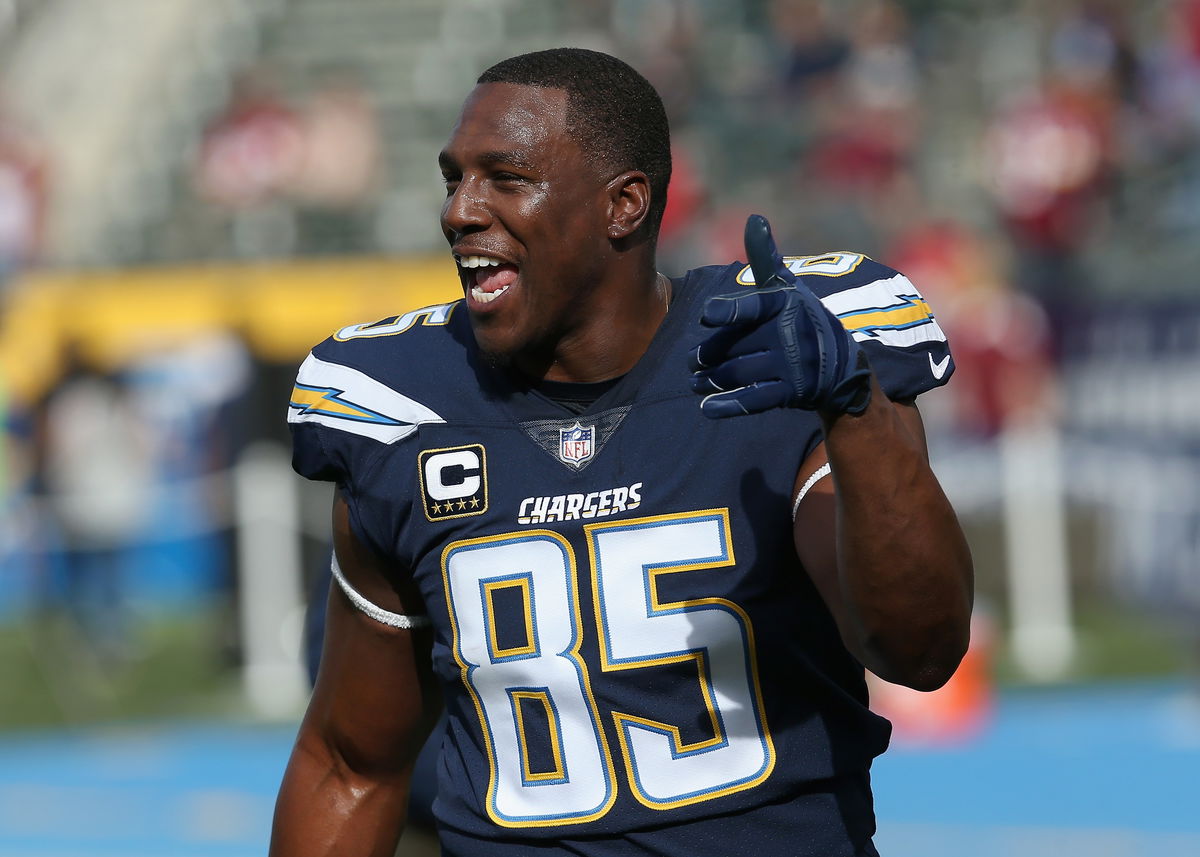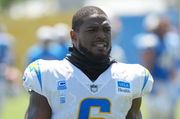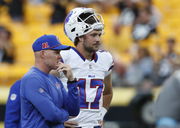

“Let’s be realistic here. To suggest that the young man, now halfway through his second year of professional football, could reach the level to which he’s come is quite remarkable.” Marty Schottenheimer delivered that vintage Martyspeak in 2004 about Antonio Gates. The San Diego coach had witnessed plenty of tight end excellence before. Ozzie Newsome dominated for him in Cleveland during those near-Super Bowl years. But Gates was different.
Watch What’s Trending Now!
The former Kent State basketball player wasn’t supposed to explode this fast. Nobody transitions from college hoops to NFL stardom in eighteen months. Less than two years after leading Kent State to the NCAA tournament, Gates emerged as an NFL playmaker. His four-game stretch of 25 catches and eight touchdowns defied logic. Schottenheimer’s flowery language couldn’t hide his amazement. Gates was supposed to be learning, not dominating. Instead, Antonio’s journey toward Hall of Fame greatness became an unexpected masterpiece.
Thursday brought the impossible story to life. Eric Smith dropped the news that sounds too wild to believe: “It’s like I’m telling a fiction story. Antonio Gates will soon be the 1st player inducted into the Hall of Fame to have never played a down of college football. Here is the inside story of Gates’ HOF career with the #Chargers.” Antonio Gates is finally in after missing the cut last year. The Class of 2025 brings Gates to August 2 in Canton alongside Eric Allen, Jared Allen, and Sterling Sharpe. History gets made this weekend when Gates becomes the first Hall of Famer who never suited up for college football. Around only 20 undrafted free agents have ever earned bronze busts in Canton. Gates just rewrote the playbook entirely. But the fact is: “Truth be told, Antonio Gates kind of detested the game of football back in high school.”
ADVERTISEMENT
“It’s like I’m telling a fiction story.”
Antonio Gates will soon be the 1st player inducted into the Hall of Fame to have never played a down of college football.
Here is the inside story of Gates’ HOF career with the #Chargers.https://t.co/Uakah95y0d pic.twitter.com/RdP1pRyRGh
— Eric Smith (@Eric_L_Smith) July 30, 2025
The man himself still can’t process the journey. “It’s like I’m telling a fiction story,” Gates told Chargers.com this summer. “To tell somebody they can come to the NFL and not play college football but then make the team … and then start … and then make the Pro Bowl and be All-Pro your second year … and then be the all-time touchdown leader … It’s not even a story you can make up. The chances? The odds? They’re crazy.” Gates dominated basketball at Detroit’s Central High School. College football? He hated everything about it. Two years of varsity ball taught him that training camps are awful and basketball was his calling. Nick Saban recruited him for football while Tom Izzo pitched basketball at Michigan State. Basketball won easily.
Three colleges later, Gates led 10th-seeded Kent State to the Elite Eight. NBA dreams filled his head after averaging 20 points in March Madness. “We were so good in basketball, in my mind I was going pro,” Gates remembered. “I was dominating, we went to the Elite Eight and I had averaged about 20 points in the tournament.” The 2003 NBA Draft crushed those dreams fast. Teams wanted him to drop 30 pounds from his 255-pound frame. “I could not lose any weight, dude,” Gates laughed. Others questioned his position entirely. Tim Brewster, the Chargers’ tight ends coach, saw the confusion differently. “He was a man without a position in basketball,” Brewster explained.
ADVERTISEMENT
Football offered what basketball couldn’t. “It was kind of like prom, right? You want to go with this person, but another person wants to go with you,” Gates explained. “I wanted to go with basketball, but [football] is who wanted to go with me.” Brewster watched Gates’ basketball tape against Kentucky and Indiana. Twenty-two points in both games convinced him. “His trunk from the lower half down was just monstrous,” Brewster noted. “And the way he cleared people playing basketball and high-pointed the ball, he was different that way.” The rest became legend.
Gates reflects on the madness: “When I think back, it’s not about the games or the stats. It’s about the journey. Never in a million years would I have thought something like this would happen.” Despite rewriting tight end history with 116 touchdowns, Gates faced Hall of Fame doubts for years before finally getting the call. His clutch gene in pressure moments – 93 red-zone touchdown catches from the 20-yard line in scoring territory – proved the difference between great stats and Canton immortality.
ADVERTISEMENT
Antonio Gates earned his Hall of Fame ticket!
Saturday marks the end of Antonio Gates’ improbable journey to Canton. The former Kent State basketball star receives his bronze bust after rewriting tight end history. But raw numbers only tell part of the story. Gates built his Hall of Fame case on something deeper than statistics; he delivered when games hung in the balance. Rob Chudzinski, who coached Gates for four seasons, watched him dominate crucial moments. “He knew when it was time to deliver,” Chudzinski explained, “and he did.” The numbers back up that assessment completely. Gates finished with 116 touchdown catches, the most by a tight end in NFL history. However, 93 of those came in the red zone, where space shrinks and pressure mounts.
No player since 2000 has scored more red zone touchdowns than Gates. Larry Fitzgerald sits second with 83. Tony Gonzalez and Jimmy Graham are tied for third with 74. Gates also dominated third and fourth downs, catching 257 conversion passes over his career. Only Fitzgerald and Anquan Boldin had more clutch catches since 2000. The combination of these situations made Gates unstoppable. On third and fourth downs in the red zone, Gates scored 37 touchdowns. Gonzalez and Greg Olsen managed 26 each. “Whether it’s crunch time, whether it was third down, whether it was to turn the momentum of the game, or whether it was in the red zone to finish a drive off, he had that mentality that he wanted the ball,” Chudzinski said.
ADVERTISEMENT
Philip Rivers threw to Gates for 13 seasons, creating a telepathic chemistry. Jason Michael, who coached both players, witnessed their silent communication. “There was hand signals, there was communication of what it is, but those guys really didn’t even have to communicate.” One play against Buffalo in 2011 exemplified that connection. Gates and Rivers changed the route mid-play without speaking. “They looked at each other, made eye contact, and they were on the same page,” Michael remembered. Touchdown followed. Gates forced defenses to create special coverages just for him. Bill Belichick and Rex Ryan double-teamed him at the line like punt coverage. Michael had the equipment staff create a practice vest with dangling pieces that defenders could grab. Gates was the only Charger who needed it.
Top Stories
Steelers Confirm $45M Punishment for DK Metcalf After NFL Suspended WR for 2-Games

NFL Suspends Chargers’ Denzel Perryman for Two Games Over Cowboys Incident

Clark Hunt Admits Being Pressured to Leave Arrowhead After Chiefs Offered $2.4B Proposal

Trent Williams Announces Retirement Plans After 49ers Clinch Playoff With Win vs Colts

Sean McDermott Confirms if Bills Will Sign a QB Amid Josh Allen’s Injury Concerns

Plantar fasciitis plagued Gates’ later years, but he played through 2018. “Whether it was a day before, week of, night before the game, he’s like, ‘Golly, this hurts,'” Michael recalled. “One night he’s talking this, and then the next night he goes out and catches for 100 yards and two or three touchdowns.” Saturday’s ceremony caps what may be the most unlikely Hall of Fame story ever told. Gates gets enshrined without playing college football, proving greatness comes in many forms. When crunch time arrived, nobody delivered like Antonio Gates.
ADVERTISEMENT
ADVERTISEMENT
ADVERTISEMENT

